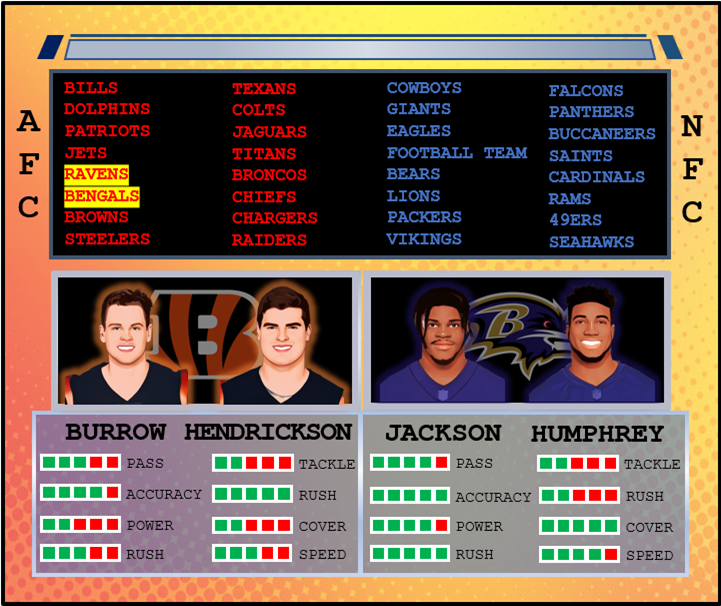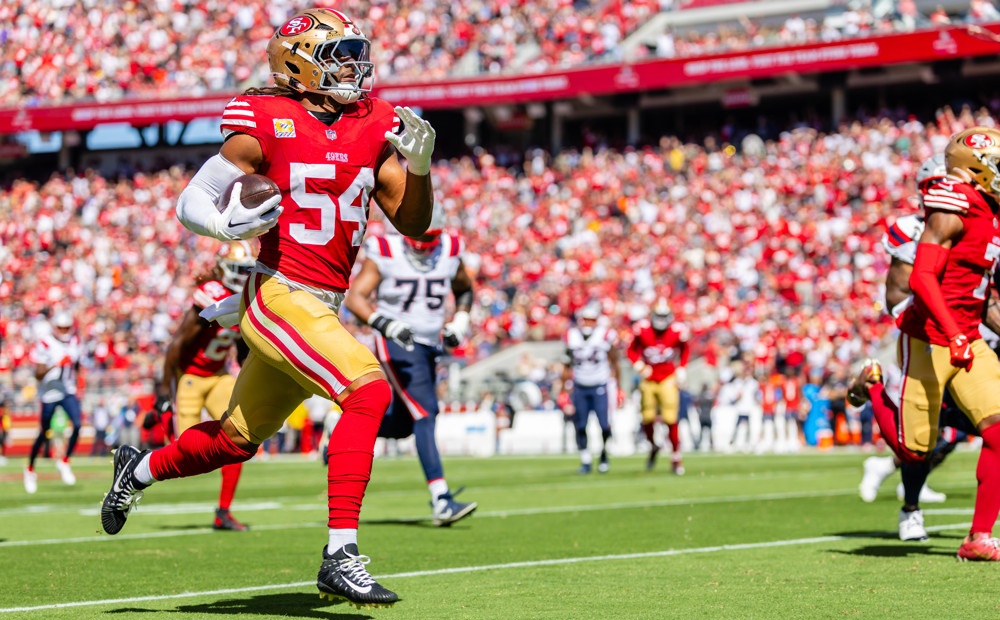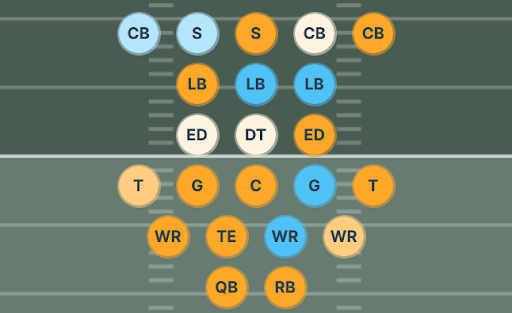By Robert Simpson
What Are Expected Points?
The concept of expected points is not a new one, as it was first developed in the 1970s. Yet, this statistical abstraction had largely been forgotten until recently, when analytics began to permeate the world of football.
Expected points metrics use historical data to find the average number of points a team is likely to score on any given drive based on down and distance. It is founded on two basic football principles: as a team gets closer to the goal line, its chances of scoring improve, while a team’s likelihood of scoring decreases on later downs. Expected points can also be negative. This indicates that a team is more likely to turn the ball over to its opponent with favorable field position than to score themselves.
Not All Yards are Created Equal
Traditionally, defenses are valued by three key statistics: yards allowed, points allowed, and turnovers. Although it is true that the more yards given up on a drive, the more likely an opponent is to score, yards in some parts of the field are worth more than others. If a defense were to give up 15 yards from their opponent’s 25-yard line, the opponent would still be far outside of field goal range, and their chances of scoring would not have substantially increased. However, if the defense had given up those same 15 yards from their own 45-yard line, the opponent would be at the 30-yard line, where the drive will almost certainly end in at least a field goal. In both situations, the defense gave up 15 yards, but in the second scenario, those yards were much more valuable.
Points surrendered also has some shortcomings. While the objective of a defense is to prevent the opponent from scoring, some points allowed are not the fault of the defense. When an offense throws a pick six or commits a safety, it unfairly counts against said team’s defense. Special teams touchdowns surrendered can also unjustly affect the perception of a team’s defense in an adverse manner. The same can be said for field goals, where if a kicker misses an attempt, the defense is credited with zero points allowed on the drive, even though they may not have affected the kick.
Turnovers are a very important part of the game, but they too fail to grasp the complete picture of a defense. While it is registered that a player makes an interception, it is important to evaluate where the interception takes place and to where it is returned. Defenses often do not get credit for long returns or even defensive scores. While all three of these stats combined can paint a good picture of a defense, there are many shortcomings that can only be overcome with the use of a new measurement.
Expected Points Allowed per Drive
Using Expected Points we can ask a very basic question of the defense, “How much better off is the offense at the end of the drive than the beginning?” Simply put, it measures the difference between expected points at the end of the drive and the beginning.
For example: if a team started their drive 1st and 10 at their own 25-yard line, it would have .635 expected points on the first play of the drive. If it were to end that drive on the opponent’s 34-yard line they would have 1.07 expected points at the culmination of the drive. Thus, over the course of the drive the defense would have surrendered .432 expected points or 1.07 ending expected points minus .635 starting expected points. Using this concept to chart the average results over the course of the season, one arrives at the statistic: Expected Points Allowed per Drive (EPA/D).
Using this approach purposely excludes what happens on the final play of the drive so as not to include results over which the defense does not have control (i.e. punt yardage or field goal accuracy). Thus, there are a few adjustments that must be made for results over which the defense has control, namely touchdowns, safeties, and turnovers.
If the offense scored a touchdown, the ending expected points would be 6.95, because in 2018 teams converted extra points 95% of the time while defensive touchdowns would be -6.95. Thus, the EPA/D for a touchdown scored would be 6.95 minus the starting expected points. If the offense commits a safety on the drive, the ending expected points would be -2, because there were two points scored against them. For field goals, the EPA/D calculation does not change, as the defense does not control the success rate of the kick.
If a non-scoring turnover occurs, the ending expected points is charted as the negative starting expected points on the next drive. This method for turnovers is applied because the defense not only allowed zero points on the drive, they also increased their offense’s chances of scoring on the subsequent drive.
Re-Ranking NFL Defenses
The chart below ranks every NFL team’s defense for the 2018 season based on the EPA/D metric, juxtaposed by three common stats used to rate defenses: yards per game, points per game, and turnovers per game. While most teams rank about where expected, there are some exceptions discussed below.
| Team | EPA/D Rank | EPA/D | YPG Rank | PPG Rank | TO Rank |
| Chicago Bears | 1 | -0.298 | 3 | 1 | 1 |
| Baltimore Ravens | 2 | -0.040 | 1 | 2 | 22 |
| Minnesota Vikings | 3 | -0.038 | 4 | 9 | 16 |
| Buffalo Bills | 4 | 0.063 | 2 | 18 | 8 |
| Houston Texans | 5 | 0.080 | 12 | 5 | 4 |
| New England Patriots | 6 | 0.181 | 21 | 7 | 5 |
| Tennessee Titans | 7 | 0.257 | 8 | 3 | 23 |
| Jacksonville Jaguars | 8 | 0.274 | 5 | 4 | 24 |
| Dallas Cowboys | 9 | 0.280 | 7 | 6 | 18 |
| Los Angeles Chargers | 10 | 0.284 | 9 | 8 | 17 |
| Indianapolis Colts | 11 | 0.298 | 11 | 10 | 10 |
| Los Angeles Rams | 12 | 0.377 | 19 | 20 | 3 |
| Cleveland Browns | 13 | 0.408 | 30 | 21 | 2 |
| Denver Broncos | 14 | 0.410 | 22 | 12 | 6 |
| Pittsburgh Steelers | 15 | 0.410 | 6 | 16 | 29 |
| New York Jets | 16 | 0.433 | 25 | 29 | 19 |
| Seattle Seahawks | 17 | 0.453 | 16 | 11 | 11 |
| Arizona Cardinals | 18 | 0.488 | 20 | 26 | 28 |
| Philadelphia Eagles | 19 | 0.556 | 23 | 13 | 25 |
| Green Bay Packers | 20 | 0.633 | 18 | 22 | 30 |
| New Orleans Saints | 21 | 0.659 | 14 | 14 | 13 |
| Detroit Lions | 22 | 0.680 | 10 | 17 | 31 |
| Washington Redskins | 23 | 0.695 | 17 | 15 | 12 |
| Carolina Panthers | 24 | 0.697 | 15 | 19 | 14 |
| San Francisco 49ers | 25 | 0.718 | 13 | 28 | 32 |
| New York Giants | 26 | 0.794 | 24 | 23 | 15 |
| Miami Dolphins | 27 | 0.874 | 29 | 27 | 7 |
| Tampa Bay Buccaneers | 28 | 0.904 | 27 | 31 | 26 |
| Cincinnati Bengals | 29 | 0.964 | 32 | 30 | 21 |
| Kansas City Chiefs | 30 | 1.014 | 31 | 24 | 9 |
| Atlanta Falcons | 31 | 1.041 | 28 | 25 | 20 |
| Oakland Raiders | 32 | 1.071 | 26 | 32 | 27 |
For the most part, teams who did well in at least two of the three traditional rankings are towards the top of the EPA/D ranking. Teams who ranked low in at least two of the three areas were towards the bottom.
One team whose placement on this list may raise some eyebrows is the Buffalo Bills. One might ask how a team that gave up so few yards and forced so many turnovers could possibly give up so many points. The answer to this question is field position. Buffalo ranked dead last in the league in opponent’s starting field position. The Bills’ opponents started drives from their own 32-yard line on average, while the Texans’ opponents started on average from their own 25-yard line, the best mark in the league.
This 7-yard difference may not seem significant, but over the course of the season, it very much is. The difference in expected points from starting at your own 25 to starting at the 32 is about .4 expected points. Last year, Buffalo’s defense faced 187 opposing drives. Multiply these drives by .4 expected points, and these 7 yards add up to 74.8 expected points over the course of the season, or 4.7 points per game. If you subtract 4.7 points per game from their defensive total, it would move them from the 18th ranked defense in PPG to 3rd. Josh Allen’s inconsistency at the helm of the offense played a major factor in the Bills losing the field position battle. As Allen gains experience in year two, this field position deficiency may improve.
The Cleveland Browns are another team that sticks out. While their yards per game were almost dead last in the league and their points per game also ranked near the bottom, they were elite when it came to forcing turnovers. In 2018, the Browns’ defense forced 31 turnovers, 10
more than the league’s average, creating a turnover on over 16% of opponents’ drives. Cleveland was also 25th in the league in opponent’s starting expected points.
Like the Bills, this was fueled by inconsistent play at quarterback, with Tyrod Taylor eventually giving up the reigns to rookie Baker Mayfield. The elite turnover rate and high opponents’ starting expected points helped the Browns overcome their lackluster performance in other areas.
A team that ranks lower than expected is the New Orleans Saints. With rankings of 14 in YPG, 14 in PPG, and 13 in TOPG, it seems like a ranking of 21 is far too low. The reason for this low ranking is that the Saints’ defense had the fewest drives faced in the league at 164. The league average for drives faced in 2018 was 179, so the Saints may have ranked No. 13 in yards given up, but that was accumulated over 15 fewer drives. Per drive, their defense was worse than these traditional measurements may suggest.
The minimal amount of opponent drives is likely due to the Saint’s prolific offense, which can eat up a lot of clock with elite back Alvin Kamara and future Hall of Fame quarterback Drew Brees. The Saints also ranked third in the league in opponent starting field position, so when they gave up big plays, it counted more heavily against them. The Panthers and Redskins were in a similar situation, both near the bottom of opponent drives and high on opponent’s starting field position.
Conclusion
Expected Points Allowed per Drive is superior to traditional defensive measurements, as it takes into consideration factors such as field position and number of opponent drives. EPA/D gives defenses proper credit for their actions and does not penalize them for factors beyond their control. EPA/D can be used to more accurately rate defenses, especially those put in bad positions by their offense.



